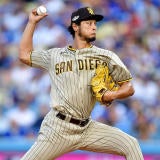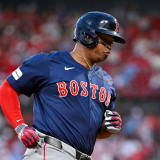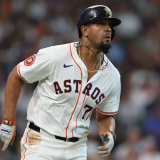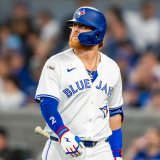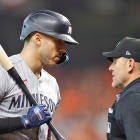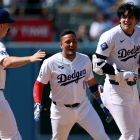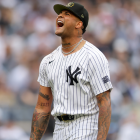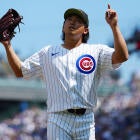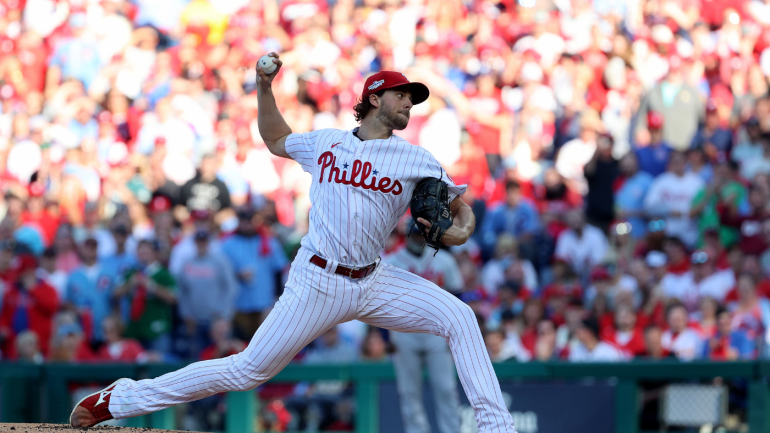
The 2022 National League Championship Series features a clash of underdogs. Neither the San Diego Padres nor Philadelphia Phillies – your two NLCS combatants – cracked 90 wins during the regular season, and in the Phillies' case they finished in third place in the NL East. En route to making it to the NLCS, the two teams combined to bounce all three NL division winners from the postseason and a total of three 100-win teams (including the 111-win Los Angeles Dodgers). Consider this to be an object lesson of the baseball chestnut that any outcome is plausible in a short series in a sport such as this one.
Whether you find a matchup of an 89-win team and an 87-win squad to be a compelling inspiration or grim bathos depends largely upon your rooting interests. For those of us without rooting interests, we might call it a refreshment. This, after all, is just the second NLCS since 2015 that doesn't involve the Dodgers or Atlanta Braves. Throw in engaging stars like Manny Machado, Juan Soto, and Bryce Harper and two vigorous fan bases starved for moments such as these – this is to say nothing of the Old Testament complications facing the Nola family – and you've got what figures to be High-Quality Color-Television Sports Action.
So get you primed for this clash of dogs – both of whom manifestly have that dog in them – we're here to lay out some NLCS x-factors. Nourishing baseball kibble forthwith!
1. The Phillies' tandem aces
We speak, of course, of Zack Wheeler and Aaron Nola (who, along with his brother, Padres catcher Austin Nola, constitute that aforementioned NLCS family feud). These two right-handers during the regular season combined for a 3.07 ERA (and 2.77 FIP) with 398 strikeouts against 63 walks in 358 innings. In the 2022 postseason, they've been even better. Wheeler through two starts has a 2.19 ERA with nine strikeouts and two walks in 12 1/3 innings. Nola through two playoff starts has allowed only one run – unearned – through 12 2/3 innings with 12 strikeouts and three walks.
As solid as likely third man Ranger Suárez has been this season, there's a steep dropoff from the duo above. The good news for Philly – and the corresponding bad news for San Diego – is that if this series goes at least six games, then Wheeler and Nola will be able to make four starts on full rest (barring issues, of course). Given the way those two have been thriving lately, that's significant. It's also one of many reasons that avoiding an NLDS Game 5 against the Braves was so critical for the Phillies. Wheeler almost certainly would've started that Game 5, which in turn wouldn't have allowed to pitch on full rest in the NLCS until Game 3. In that scenario, Wheeler's hypothetical second start against the Padres wouldn't have come until a Game 7, and that would have been on short rest.
2. Juan Soto
The Padres' headline-grabbing deadline addition hasn't really found his level with San Diego. Mind you, he was still really good during the regular season after the trade – a 130 OPS+ and a .388 OBP in 52 games for the Pads -- but he wasn't up to his usual standards. That has continued to be the case through the first two rounds of the postseason. In the three games against the Mets, Soto had a .718 OPS, which is hardly disastrous but, again, not customary. His outputs were worse against the Dodgers, but the difference was that Soto squared the ball up quite often against L.A. There's a lot of luck, good or bad, in short-run numbers, especially at the individual level, and Soto had a number of well-struck balls that found gloves. If you're a Padres rooter, then you take that as an encouraging sign heading into the NLCS – i.e., that Soto is on the cusp of going off. What also may be in Soto's favor is that against the Phillies he won't be facing a left-handed starter 75 percent of the time, which is what happened in the NLDS against the Dodgers.
3. The schedule
Thanks to the owner-induced lockout way back in the winter, the entire 2022 MLB calendar was substantially compressed, and that includes the playoffs. Insofar as the NLCS is concerned, best-of-seven series such as this one typically have an off day between Games 2 and 3 and then Games 5 and 6 for travel. This time around, the Phillies and Padres will have an off day only between Games 2 and 3 and not between Games 5 and 6:
- Game 1: PHI @ SD, Tuesday, Oct. 18, 8:03 p.m. ET
- Game 2 PHI @ SD, Wednesday, Oct. 19, 4:35 p.m. ET
- Game 3 SD @ PHI, Friday, Oct. 21, 7:37 p.m. ET
- Game 4 SD @ PHI, Saturday, Oct. 22, 7:45 p.m. ET
- Game 5 SD @ PHI, Sunday, Oct. 23, 2:37 p.m. ET (if necessary)
- Game 6 PHI @ SD, Monday, Oct. 24, 8:03 p.m. ET (if necessary)
- Game 7 PHI @ SD, Tuesday, Oct. 25, 8:03 p.m. ET (if necessary)
If the series lasts long enough to go back to San Diego, then the two teams will be facing a cross-country flight after Game 5 followed by Game 6 the next day. That's taxing, but it's fair since both teams must cope with those circumstances. This schedule in essence eliminates the possibility of any pitcher making three starts in the series.
Of further note given the loss of that one day of rest is that the Padres' bullpen comes into this series having worked 24 2/3 postseason innings across 23 appearances. The Phillies' bullpen has racked up 21 2/3 postseason innings across 22 appearances. Maybe there's a fatigue edge for the Phils in there, one that could increase given that, as noted above, their two workhorse aces are lined up to start four of the first six games of the NLCS.
4. Game 3
Game 3 typically marks an important pivot point in a best-of-seven series, and the NLCS figures to be no exception. The likely outcome is that one team is going to have a 2-1 lead after Game 3 (3-0 series tallies are comparatively uncommon), and across the history of MLB best-of-seven series the team that leads 2-1 goes on to win the series more than 70 percent of the time.
Specific to this series, Game 3 will mark the shift to Philly, but on the other side it also marks the first time in the series that the Padres may have the starting-pitching edge. Regardless of whether Blake Snell or Joe Musgrove follows up Game 1 starter Yu Darvish, the Game 3 starter for San Diego should be better positioned to succeed than Suárez. Yes, the Phillies' front end is better, but the Padres' front end is deeper. Coming off the only off day of the series and perhaps getting some length from Wheeler and Nola in Games 1 and 2, Phils manager Rob Thomson may seek to blunt that presumed advantage via preemptive hook and a bullpen-heavy game. The lofty stakes of Game 3 are noted above, and how each manager responds to those stakes will be interesting.
5. The fourth starters
There's no obvious fourth starter for either team, but they'll very likely be forced to turn one up. Do the Padres stick with Mike Clevinger, who hasn't been in his usual form all year and who got pretty well incinerated by the Dodgers in the NLDS? Will Bob Melvin be in a position to make it a bullpen game? Does he try the disappointing Sean Manaea knowing the Phillies are one of MLB's best offenses against lefties?
Across the way, does Rob Thomson try to piggyback, say, Kyle Gibson and Bailey Falter? Does he "bullpen it" coming off what may be a reliever-heavy Game 3 for Philly?
Questions? They abound, at least when it comes to NLCS fourth starters.









